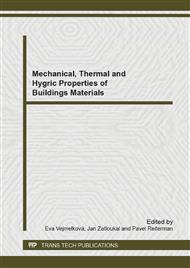p.114
p.119
p.125
p.130
p.136
p.141
p.145
p.149
p.154
Differences in the Properties of Arenaceous Marlstones from Different Quarries
Abstract:
In this article two arenaceous marlstones quarried in Czech Republic were compared. Thanks to its easy workability and many deposits, arenaceous marlstone belonged to the main building materials in Roman and Gothic style. In the Czech Republic many interesting historical buildings from this period still exist, and they need to be sometimes repaired. It is important to use similar material for conservation of historical values of these monuments. From the geological point of view arenaceous marlstone is sedimentary rock containing loamy and silty particles. But as it was proved in this study two functioning quarries in the Czech Republic supply two materials with extremely different properties. Open porosity varies by about 33%, compressive strength by about 65% and also thermal and hygric properties are almost incomparable.
Info:
Periodical:
Pages:
149-153
Citation:
Online since:
July 2014
Price:
Сopyright:
© 2014 Trans Tech Publications Ltd. All Rights Reserved
Share:
Citation:



